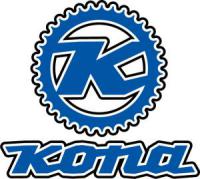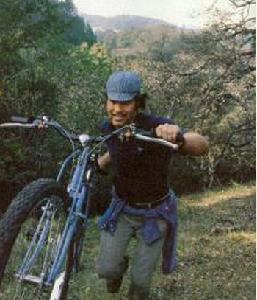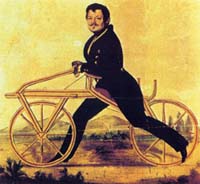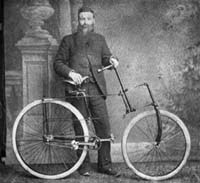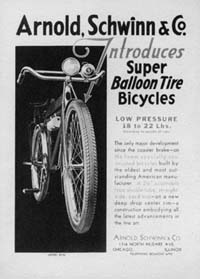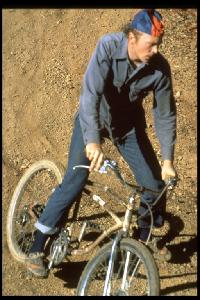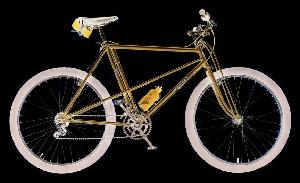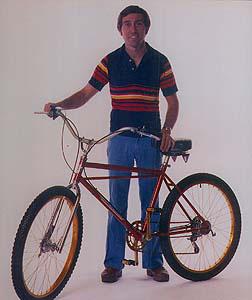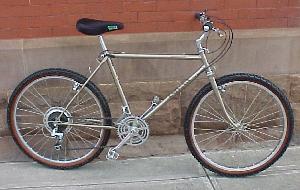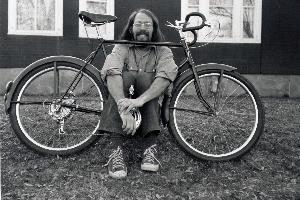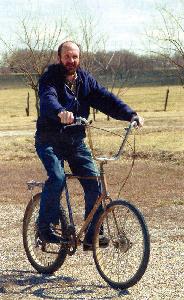Originally written by Joe Breeze, July ’96
|
|
This section was originally written by Joe Breeze. The Mountain Bike Hall of Fame has expanded on this topic with the addition of a few other bikes and categories. The MBHOF additions are denoted with an asterisk*.
|
|
First bicycle ridden off road:
|
|
This depends on one’s definition of bicycle. In 1816 Baron Karl von Drais built what came to be known as a draisine. He rode it in the forests of the Duke of Baden as the duke’s “Master of Woods and Forests”.
|
|
First bike with pneumatic tires ridden off road:
|
|
In 1887, Irish veterinary surgeon John B. Dunlop fitted a piece of rubber hose to his son’s bicycle. The superior air suspension this provided over solid tires led to world-wide acceptance by 1891. Tire sizes were commonly 30 x 1.5” and 28 x 1.5”. No doubt, bikes with these tires were ridden on dirt, as there were few paved roads.
|
|
First bike with fat tires ridden off road:
|
|
The “fat tire,” that is one having a cross-sectional diameter of 2” or more, is what later fired the imagination of so many to how far a bicycle could go off road. It gave the mountain bike its extreme degree of ruggedness. Bicycle fat tires, also known as balloon tires, came into existence in the early 1930s, possibly late 1920s. Whether the first balloon-tire bike to be ridden off road was American or European (possibly German), I don’t know. Semperit had a 26 x 2” tire in the early 1930s. Arnold, Schwinn & Co. of Chicago was introduced to such a tire in Germany in 1932 and popularized the size in America.
|
|
First fat-bike with a derailleur ridden off road:
|
|
As far as I know it was Russ Mahon of Cupertino, California (75 miles south of Marin County), who came up with this combination, in 1973. He grafted derailleurs onto a 1930s balloon0 tire bike built by the Cleveland Welding Company. He also put thumbshifters on this bike. Three Cupertino riders including Mahon showed up at a Cyclo-cross race in Marin, December 1974, pollinating Marin with these ideas. They then departed the scene for more than 20 years
|
|
First fat-tire bike with a derailleur and good brakes in Marin:
|
|
Gary Fisher’s 1938 Schwinn-built B.F. Goodrich (Excelsior-type), Fairfax, California, September ’74 or summer ’75. This much-photographed bike is equipped as it appeared in late 1978, but it is basically circa 1976.
Image Courtesy of Wende Cragg
|
|
First fat-tire bike with a new frame and all new parts:
|
|
Breezer # 1, frame and bike built by Joe Breeze for himself, Mill Valley, California, (Marin County), Oct. 1977. This was one of ten Breezers I built at the time. The frames were built of straight 4130 large-diameter, thin wall tubing. The term “clunker no longer applied to all bikes ridden on Mt. Tam.
Image Courtesy of the Oakland Museum
|
|
First fat-tire custom built bike regularly available:
|
|
1979 Ritchey/MountainBikes. In 1979 Tom Ritchey of Redwood City, California (50 miles south of Marin) started building fat-tire frames. From 1980 onward he built hundreds of fat-tire bike frames each year. These were the first bikes sold by Gary Fisher and Charlie Kelly, founders of MountainBikes (later the Gary Fisher Bicycle Company). Fisher and Kelly assembled the frames into bikes and sold them for about $1400.00. In 1979, MountainBikes became the first business to sell mountain bikes exclusively.
Image Courtesy of Wende Cragg
|
|
*First Production Mountain Bike Available-1978
|
|
1978 Lawwill Pro Cruiser.
One of the bikes that bridged the gap between BMX bikes and mountain bikes. The frame design was based on frame that Don Koski fabricated from electrical conduit and a Schwinn Varsity frame. Mert Lawwill had Terry Knight of Oakland build the frames. The bikes sold for about $500 new and were made from 1978 though 1980 (approximate run of 600 bikes).
Text courtesy of the Museum of Mountain Bike Art and Technology.
|
|
First fat-tire bikes widely available under $1000.00:
|
|
There were two; the 1982 Specialized Stumpjumper, made in Japan for Specialized Bicycle Imports of San Jose, California and the Univega Alpina Pro, also made in Japan for Ben Lawee, owner of Lawee Inc. parent company for Univega in Long Beach, Ca. These bikes, which first appeared at a bike trade show in September 1981, became available in 1982. The price for the Stumpjumper was $850 and the Alpina Pro was $695. Over the next two years, thousands of these bikes were sold.
Image Courtesy of Specialized
|
|
*1983 Univega Alpina Sport
|
|
One of the earlier bikes from Univega. Not the original spoken of in the above text. Pretty much just a standard bike from the early days: parts from about every maker on the planet hung on a decent lugged frame. The TA Cyclotourist patterned Sugino crank is kinda neat.
Image and text courtesy of the Museum of Mountain Bike Art and Technology.
|
|
*First Mountain Bike with a Disc Brake: Tankagnlolo: And First Mountain Bike in the Pacific Northwest
|
Built in Spokane, Washington in the spring of 1974, for riding in snow, Bob Crispin widened the frame of a Schwinn Varsity and added the unique features of a Shimano Disc brake and Shimano alpine gearing. The following summers found him riding the trails of Spokane and having others ask him to build bikes for them. The story was published in the May/June 1978 issue of Bike World Magazine. Image and text courtesy of Bob Crispin I invite all who have such a story to submit it to me at pambob@pcez.com and check out www.mtbprehistory.blogspot.com. |
|
*First Purpose-Built Mountain Bike with Two Drum Brakes, Derailleurs and a New Frame with All New Parts: And First Mountain Bike East of the Mississippi
|
|
Built by Rodney Rom of Cincinnati, Ohio ("The City of Seven Hills"), in the spring of 1966 by widening the rear of a new 10-speed Schwinn Varsity Tourist frame, then adding special-ordered heavy-duty spokes, S-7 rims and imported German Union drum brakes. The frame was then completely chrome-plated. This bike's story was published in the August 2003 issue of Mountain Bike magazine, pages 16-17, with a misquoted headline. The bike also traveled to the east coast, Europe and South America as authorized cargo on board the Navy aircraft carrier USS Randolph (CVS-10).
Image and text courtesy of Rodney Rom
|
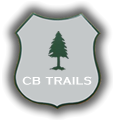
 Crested Butte History
Crested Butte History 